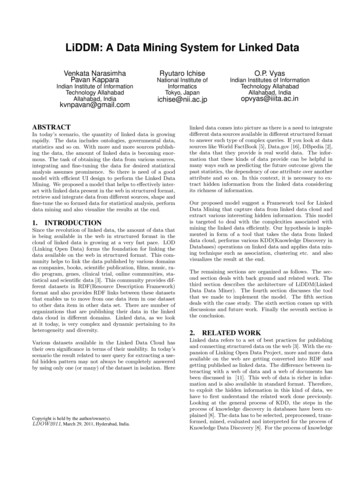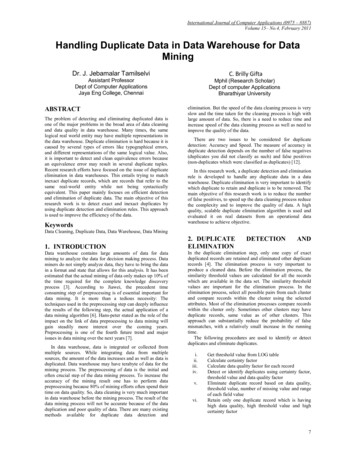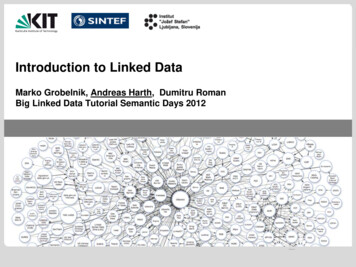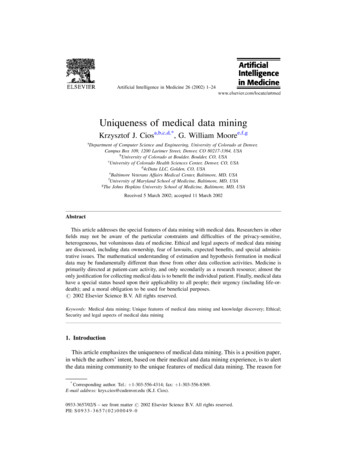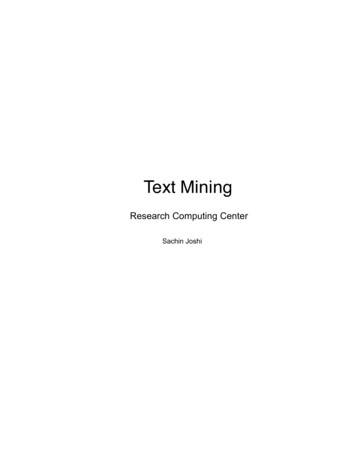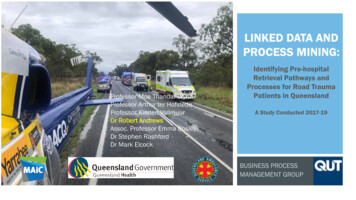
Transcription
LINKED DATA ANDPROCESS MINING:Professor Moe Thandar WynnProfessor Arthur ter HofstedeProfessor Kirsten VallmuurDr Robert AndrewsAssoc. Professor Emma BosleyDr Stephen RashfordDr Mark ElcockIdentifying Pre-hospitalRetrieval Pathways andProcesses for Road TraumaPatients in QueenslandA Study Conducted 2017-19
PROCESSES AND PROCESS MINING Processes are ubiquitous a set of steps designed to achieve a goal process steps are carried out in an order Some steps can happen while other steps are happeningprocess steps are carried out by an agent – person,machine, IT system process steps are carried out at given time process steps are recorded in IT systemsStructured processesrigorously defined with an end-to-end model, that takes intoaccount all the process instance permutations. No processinstance can stray from process modelUnstructured processes Some steps can’t happen before a previous step has completed every process instance can be differentStructured --- Medical ---- rkflows2
PROCESS MINING DATA MINING PROCESS MANAGEMENT VISUALISATIONAutomated process discovery - What is the actual patientjourney?Conformance checking - To what extent do we follow clinicalguidelines?Performance analysis - Where do unacceptable waiting timesoccur?3
PROJECT BACKGROUND Road accidents happen all across the state (and Qld is BIG!) and road trauma accounts for a big percentage of alltrauma patients treated in the Qld Health system. Study questions What is the range of care, retrieval & transport processes for road trauma patients? What is the degree of conformance (to guidelines) and comparative performance analyses for the different cohorts? What is the level of conformance to Trauma By-pass Guideline ? Approach Understand the process and available data Assess the quality of QAS, RSQ, EDC and QHAPDC time/event data Align our understanding of the process and data with stakeholders Data extraction, Linking, Log generation, and Process modelling4
UNDERSTAND THE PROCESS How – interviews, literature We learned – general process We developed – initial model5
UNDERSTAND THE DATA What is relevant, what isavailable, from where? Methods schema and dictionaries ofcandidate data sources Outputs data models (ORM) of QAS and RSQdata PHA and request for data from QAS6
DATA QUALITY ASSESSMENT Garbage in – Garbage out Multi-dimensional concept dimension – some measurableaspect of data, e.g. accuracy,completeness, precision,currency, no single dimension provides anoverall view of quality Metrics indicate effects onprocess mining Attribute level metrics Precision - mixed (with somelow level) indicates eventordering issuesquality of each dimension can bemeasuredAndrews, R., Wynn, M.T., Vallmuur, K., ter Hofstede, A.H.M., Bosley, E., Elcock, M., Rashford, S. Pre-hospital retrieval and transport of road trauma patients in Queensland: Aprocess mining analysis. In 1st International Workshop on Process-Oriented Data Science for Healthcare (PODS4H), 2018, Sydney, N.S.W.7
DATA QUALITY ASSESSMENT Has both diagnostic (why do these issues occur – people, system, policy) and prognostic (anticipate effects we will see in modelling)Look AheadLook BackReason about causes, whatcan be done to fix qualityissuesETLData QualityMetricsAnticipate effects on process mining,e.g. parallelism where there should besequenceAndrews, Robert, Wynn, Moe, Vallmuur, Kirsten, ter Hofstede, Arthur, Bosley, Emma, Elcock, Mark, et al. (2019) Leveraging data quality to better prepare for process mining: Anapproach illustrated through analysing road trauma pre-hospital retrieval and transport processes in Queensland. International Journal of Environmental Research and PublicHealth, 16(7), Article number: 11381-25.
STUDY DATA All road traffic crash s between 1/7/2015 and 30/6/2017 QAS – all 92,420 CAD and eARF data (AMPDS 29) RSQ – all 9,082 transports Jul 2015 to Jun 2017 EDC – all 32,100 presentations (that could be) matched with QAS transportsto Qld Health reporting facilities QHAPDC – all 19,462 admissions (that could be) matched with QAStransports to Qld Health reporting facilities Deaths – all 371 deaths (that could be) matched with QAS transports to QldHealth reporting facilitiesRSQQASDLUEDCQHAPDC Observations (at the time of the study): no common patient identifier challenges in linking (approximate, manual matchingby DLU) hinders end-to-end patient journeymodelling added to time from request to provision of data9
EVENT LOG GENERATIONQASAttend This cohort represents 51.22% of cases and72.8% of recorded events Large number of trace variants relative to thenumber of cases, i.e. complex Highly variable process execution interleaving of events, e.g. HOSPITAL ADMIT can occurat various points while the patient is in ED incorrect sequencing due to mixed timestampgranularity multiple responding units Inter-hospital transfersTransportQAS\RSQNumber of casesNumber of (trace) variantsStart dateEnd dateCase duration (min)Case duration (max)Case duration (median)Case duration (mean)Number of eventsEvents per case (min)Events per case (max)Events per case (median)Events per case (mean)Hospital(24hr) Hospital( 24hr)Discharge21,8202,80001/07/2015 05:38:13 AEST06/07/2017 14:52:00 AEST53 mins 26 secs7 days, 23 hours14.9 hours35.1 hrs132,4475451312.25
OUR UNDERSTANDING OF PATIENT JOURNEYS(32,069 calls)(42,603 patients)‘000’DispatchPrimary(272 patients)(3,847 qualifying patients)Major Trauma By-passInter-hospitalTransfer (402 patients)(30,051 patients)Died atsceneNearestTreat at scene,No transport(370 patients)Major/RegionalTrauma ServiceDied inED/Hospital(61 patients)OtherNearest(12,552 patients)Major/RegionalTrauma ServiceDischarged/Transfer(21,322 patients)11
12Process Mining Outcomes - DiscoveryAttend/transport activitiesED activitiesInter-hospital transfer(which may be skipped)Block structures foractivities in each traumaservice level Other Regional TSMajor TS IHT originate mainly other (62%) or RTS (29%)Relatively few deaths in ED/HospitalPatient OutcomesDeath or Transfer/DischargeAndrews, Robert, Wynn, Moe T., Vallmuur, Kirsten, Ter Hofstede, Arthur H.M., & Bosley, Emma (2020) A comparative processmining analysis of road trauma patient pathways. International Journal of Environmental Research and Public Health, 17(10),Article number: 3426.12
13Process Mining Outcomes - Performance by Transport SegmentInitial Attend and TransportInter-hospital TransportAndrews, Robert, Wynn, Moe T., Vallmuur, Kirsten, Ter Hofstede, Arthur H.M., & Bosley, Emma (2020) A comparative processmining analysis of road trauma patient pathways. International Journal of Environmental Research and Public Health, 17(10),Article number: 3426.13
14MAJOR TRAUMA BY-PASS CONFORMANCEConformsOver-triage ResearchQuestions Under-triageWhat is the degree of conformance to QAS Clinical Guideline – Trauma Bypass? What are the levels of over- and under-triage and are they within acceptablelimits? What are the most frequently occurring criteria for patient meeting criteria fortrauma by-pass? 65% conformance 16% over-triage 19% under-triage Within acceptable limits Majority of over-triage whereguideline recommended transport toother, i.e, no RTS or MTS within45mins 85% of cases met only a singlequalifying criterion Vital sign Vehicle Rollover 50% of cases only requiredtreatment at EDAndrews R, Wynn MT, Vallmuur K, Elcock M, Rashford S, Bosley E, ter Hofstede AHM. TraumaAndrews, Robert, Wynn, Moe Thandar, Vallmuur, Kirsten, Elcock, Mark, Rashford, Stephen, Bosley, Emma, et al. (2021) Trauma by-pass guideline: A data-driven conformanceBy-pass Guideline: A Data-driven Conformance Analysis for Road Trauma Cases in Cases inanalysis for road trauma cases in Queensland. EMA - Emergency Medicine Australasia.Queensland, Emergency Medicine Australasia (In Press).14
PATIENT OUTCOMES – TRANSPORT TO LOWER LEVEL THAN RECOMMENDED BY GUIDELINES The table shows (i) the last recordedevent, and (ii) LoS, for each patient ineach cell that represents transport to alower trauma service thanrecommended by the guidelines
THANK YOU FOR LISTENING - ANY QUESTIONS?Dr Robert AndrewsBusiness Process Management GroupSchool of Information Systems, Faculty of ScienceQueensland University of Technologyr.andrews@qut.edu.auAndrews, R., Wynn, M.T., Vallmuur, K., ter Hofstede, A.H.M., Bosley, E., Elcock, M., Rashford, S. Pre-hospital retrieval and transport of road trauma patients in Queensland: Aprocess mining analysis. In 1st International Workshop on Process-Oriented Data Science for Healthcare (PODS4H), 2018, Sydney, N.S.W.Andrews, Robert, Wynn, Moe, Vallmuur, Kirsten, ter Hofstede, Arthur, Bosley, Emma, Elcock, Mark, et al. (2019) Leveraging data quality to better prepare for process mining: Anapproach illustrated through analysing road trauma pre-hospital retrieval and transport processes in Queensland. International Journal of Environmental Research and PublicHealth, 16(7), Article number: 11381-25.Andrews, Robert, van Dun, Chris, Wynn, Moe Thandar, Kratsch, Wolfgang, Roglinger, Max, & ter Hofstede, Arthur (2020) Quality-informed semi-automated event log generation forprocess mining. Decision Support Systems, 132, Article number: 113265.Andrews, Robert, Wynn, Moe Thandar, Vallmuur, Kirsten, Elcock, Mark, Rashford, Stephen, Bosley, Emma, et al. (2021) Trauma by-pass guideline: A data-driven conformanceanalysis for road trauma cases in Queensland. EMA - Emergency Medicine Australasia.
PROCESSES AND PROCESS MINING Processes are ubiquitous a set of steps designed to achieve a goal process steps are carried out in an order Some steps can't happen before a previous step has completed Some steps can happen while other steps are happening process steps are carried out by an agent - person, machine, IT system

